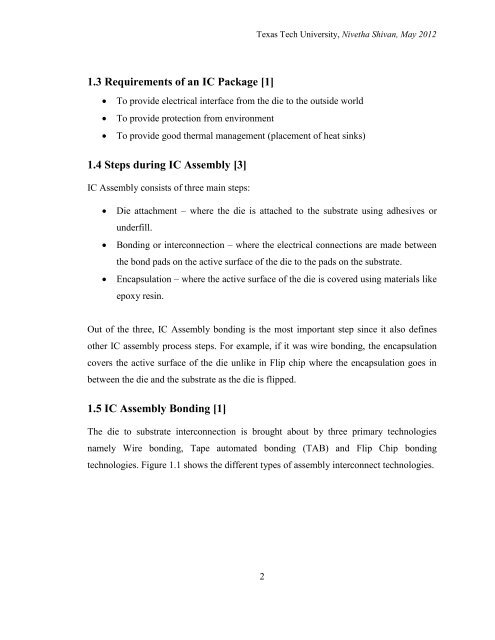Qualification of the Assembly Process of Flip-Chip BGA Packages ...
Qualification of the Assembly Process of Flip-Chip BGA Packages ...
Qualification of the Assembly Process of Flip-Chip BGA Packages ...
Create successful ePaper yourself
Turn your PDF publications into a flip-book with our unique Google optimized e-Paper software.
1.3 Requirements <strong>of</strong> an IC Package [1]<br />
Texas Tech University, Nivetha Shivan, May 2012<br />
� To provide electrical interface from <strong>the</strong> die to <strong>the</strong> outside world<br />
� To provide protection from environment<br />
� To provide good <strong>the</strong>rmal management (placement <strong>of</strong> heat sinks)<br />
1.4 Steps during IC <strong>Assembly</strong> [3]<br />
IC <strong>Assembly</strong> consists <strong>of</strong> three main steps:<br />
� Die attachment – where <strong>the</strong> die is attached to <strong>the</strong> substrate using adhesives or<br />
underfill.<br />
� Bonding or interconnection – where <strong>the</strong> electrical connections are made between<br />
<strong>the</strong> bond pads on <strong>the</strong> active surface <strong>of</strong> <strong>the</strong> die to <strong>the</strong> pads on <strong>the</strong> substrate.<br />
� Encapsulation – where <strong>the</strong> active surface <strong>of</strong> <strong>the</strong> die is covered using materials like<br />
epoxy resin.<br />
Out <strong>of</strong> <strong>the</strong> three, IC <strong>Assembly</strong> bonding is <strong>the</strong> most important step since it also defines<br />
o<strong>the</strong>r IC assembly process steps. For example, if it was wire bonding, <strong>the</strong> encapsulation<br />
covers <strong>the</strong> active surface <strong>of</strong> <strong>the</strong> die unlike in <strong>Flip</strong> chip where <strong>the</strong> encapsulation goes in<br />
between <strong>the</strong> die and <strong>the</strong> substrate as <strong>the</strong> die is flipped.<br />
1.5 IC <strong>Assembly</strong> Bonding [1]<br />
The die to substrate interconnection is brought about by three primary technologies<br />
namely Wire bonding, Tape automated bonding (TAB) and <strong>Flip</strong> <strong>Chip</strong> bonding<br />
technologies. Figure 1.1 shows <strong>the</strong> different types <strong>of</strong> assembly interconnect technologies.<br />
2

















